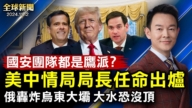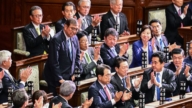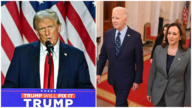【新唐人2012年11月19日訊】在美國大選和中共18大相繼落下帷幕之後,美國總統奧巴馬開始進行連任之後的首次出訪,目地是對於美國重返亞太戰略至關重要的東南亞,包括與中共越來越疏遠的緬甸。中共喉舌對此反應強烈,指稱奧巴馬此行是在「挖牆角」。分析人士則指出,美國希望東盟擺脫中共干擾,真正發揮作用。
17號,奧巴馬啟程出訪泰國、緬甸及柬埔寨三國,並將出席20號在柬埔寨首都金邊舉行的第21屆東盟峰會。與奧巴馬幾乎同時奔赴東南亞的,還有美國國務卿希拉里•克林頓和國防部長帕內塔。
中共喉舌對奧巴馬一行反應強烈,報導聲稱,泰國、緬甸及柬埔寨這三個與中共親近的國家,干擾了美國重返亞太戰略,奧巴馬此行旨在挖中共牆腳,削弱中共對東南亞的影響力。
時事評論家文昭:「挖牆腳的意思就是說,中共以前在這一地區下了不少力氣。比方說緬甸,它(中共)長期支援緬甸軍政府;再比如說柬埔寨,它提供了巨額的低息貸款,來扶持柬埔寨。就是說它在這一地區還是下了不少力氣,來拉攏這些國家。」
資料顯示,東南亞一帶的馬六甲海峽可以北上日本及朝鮮半島,南下直通澳大利亞,地理位置非常險要。二戰時,美國和日本就曾為此在南太平洋激戰。上世紀60年代,美國開始在東南亞構建包括泰國、印尼、馬來西亞、新加坡和菲律賓等國在內的東盟組織,力圖隔離越南、中國大陸和蘇聯的共產黨紅色政權。目前東盟擁有10個成員國,兩年前與中國建立自由貿易區。
時事評論家文昭分析指出,由於中共對東盟成員泰國、緬甸、柬埔寨等國的長期拉攏,造成東盟很難在一些重要事務上形成統一意見。奧巴馬此行的目地就是為了調和東盟內部關係,使東盟真正發揮作用。
文昭:「美國的利益來講,它是希望東盟成為一個凝聚力比較強的、在關鍵的地區事務上能夠形成一個統一意志的、能夠形成一個共同意見的國際組織。中共就不希望這種情況發生。」
奧巴馬此次東南亞之行,恰逢中美兩國剛剛完成最高權力交接。因此,有大陸媒體認為,美國是有意選擇東南亞作為奧巴馬連任後的首次出訪地。
文昭:「東南亞是它(美國)整個亞太戰略中比較重要的一部分,只不過是前段時間由於總統大選,對他競選連任優先性更強,所以暫時把它(出訪東南亞)放在後面了。他一旦連任成功以後,這個壓力消失以後,他還得按部就班、照他以前定的方略去做。」
文昭談到,美國重返亞太有政治、經濟和軍事上全方面的考慮。目前亞太是全球經濟最有增長潛力的地區,美國作為亞太國家之一,希望參與到亞太經濟成長的過程中,從而維持美國的經濟繁榮。此外,美國將把一半以上的戰艦部署在亞太,以防止中日、台灣海峽、南海等熱點爭議地區出現大的戰爭和動盪,影響全球經濟安全。在政治上,美國也希望加強對亞洲包括對中國大陸的影響力。
奧巴馬對緬甸和柬埔寨的訪問,使他成為美國歷史上首次造訪這兩個國家的總統。香港《東方日報》報導,泰國民間對奧巴馬來訪反應積極,認為這將提升兩國關係。根據日程,奧巴馬將與緬甸反對黨領導人翁山蘇姬會面,力圖促進緬甸民主進程。奧巴馬還將會晤出席東盟峰會的中共國務院總理溫家寶以及日本首相野田佳彥。
採訪/劉惠 編輯/李謙 後製/肖顏
Obama’s Asia Tour Accused of Undermining CCP Regime
After the U.S. presidential election and ending of the Chinese
Communist Party (CCP) 18th Congress,
U.S. President Barack Obama started his first post election
international trip Obama’s Asia tour covers Southeast Asia,
an essential area in its Asia-Pacific Strategy. This includes Burma,
which has increasingly alienated itself from the CCP regime.
CCP mouthpiece media reacted strongly over the issue,
alleging Obama is undermining CCP influence over there.
Political observers say that the U.S. intends to help ASEAN
to truly play its role by getting rid of interference from the CCP.
President Obama has begun his visit to Thailand,
Burma and Cambodia.
He is scheduled to attend the 21st ASEAN Summit held
in Cambodia on November 20.
Secretary of State Hillary Clinton and Secretary of Defense
Leon Panetta accompany Obama on the trip.
Obama’s Asia trip has incurred strong reaction from
the CCP official media have asserted that
the three pro-CCP Countries have interfered with
U.S. return to Asia-Pacific strategy.
And that Obama’s visit aims at undermining CCP
Influence over Southeast Asia.
Critic Wen Zhao: “In the past, the CCP has made great effort
to dominate this region.
For example, the CCP is in long-term support of
the Burmese military government.
The CCP has also offered huge amounts of low-interest loans
as back up to the Cambodian authorities.
All these efforts have been made to woo these countries."
The Malacca Strait, with its commanding position, connects
Japan, the Korean peninsula and Australia.
During World War II, the U.S. and Japan staged a war
to grab control of this key area.
In the 1960s, the U.S. started to form ASEAN, covering
Thailand, Indonesia, Malaysia, Singapore the Philippines.
Its goal was to separate this region from Communist states
including Vietnam, mainland China and the former Soviet Union.
So far, ASEAN has 10 member states, and two years ago,
the China-ASEAN free trade area came into effect.
Wen Zhao says, the CCP has long roped in these ASEAN
member states.
This has created difficulty for ASEAN to achieve consensus
over some important issues.
Obama’s South Asia tour is to reconcile intra-ASEAN
relations and make ASEAN really work.
Wen Zhao: “The U.S. intends ASEAN to play a role in uniting
Asian countries to reach consensus over important regional issues.
This is against the CCP’s wishes."
Obama’s Asia trip has only recently been staged after
completion of the power transition in both countries.
China’s media has asserted that the U.S. intentionally
chose Southeast Asia as Obama’s first post-election visit.
Wen Zhao: “Southeast Asia is an important part of
the entire U.S. Asia-Pacific strategy.
The trip to the region was put aside due to the U.S.
presidential election.
So after Obama got re-elected, he still follows prescribed
policies to make that trip."
Wen Zhao analyzes that the U.S. return to the Asia-Pacific
region is based on economical, political and military considerations.
The region is deemed an area with the greatest potential
for growth. The U.S. is a signatory of the pact between Asia-Pacific countries.
By taking part in the region’s economic growth, the U.S. wants
to maintain its own prosperity, Wen Zhao remarks.
The U.S. deployment of over half of its warships to the region
aims to prevent the occurrence of large-scale war or
unrest in the region, which would impact
global economic security.
Wen Zhao interprets that the U.S. also intends to strengthen
its political influence over Asia, including mainland China.
Obama’s trip to Burma and Cambodia has made him
the first U.S. President to visit the two countries.
Hong Kong’s Oriental Daily newspaper reported on
the positive response given by the Thai people to Obama’s visit.
It said that this trip will improve US-Burma relations.
Obama is scheduled to meet Aung San Suu Kyi,
Myanmar’s opposition leader, to promote country’s democratic process.
The US president is also expected to meet CCP Premier
Wen Jiabao and Japanese Prime Minister Yoshihiko Noda at the summit.




























